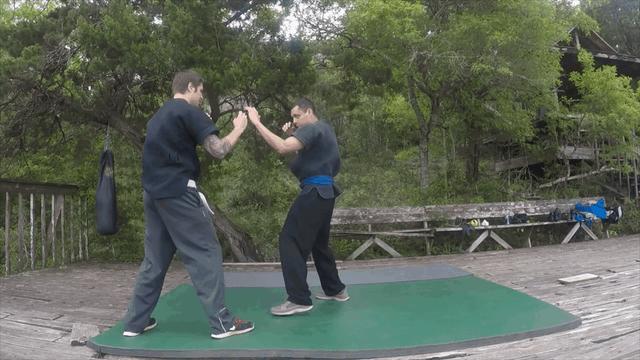isshinryuronin
Senior Master
Stances are leg positions in 5-D: Depth, width and height are the obvious three. The 4th dimension is weight distribution/center of gravity placement. The 5th is hip position/body angle. These 5 elements determine various capabilities in getting out of the stance. In other words, the value of stance is not the stance itself, but what body motion it allows. Stances are static, combat is dynamic. A stance is the beginning and ending point of a dynamic motion. This motion may be simply shifting from one stance to another while essentially staying in one spot by changing one or more of the 5 D's, or the motion can result in moving to another spot by stepping. Both kinds have combat applications (bunkai). I'll leave stepping for later.
Shifting from a back stance into a forward stance the body mass/center of gravity is moved forward. This provides power in a reverse punch. If you are in very close range, the front knee moving forward as a result of this shift can make contact with the opponent's lead leg and break his balance.
Pivoting rear foot outward from a neutral stance to a seiuchin (open toed horse) stance will change body angle, moving the rear hip back. If your rear hand is engaged with the opponent's arm, his arm will be pulled (providing your arm is structurally connected to your hip), extending it for an elbow break. This stance shift will also lower your height and center of gravity to add extra power and provide stability while grappling. (More than one "D" can be put into play with a single shift.)
These are just a few examples of how simple stance changes have bunkai. By noting stance changes in kata new interpretations may be discovered in the accompanying technique. "Why is there a stance change here?" A few years ago, I re-visited all my kata with this question in mind and was surprised a couple of times at what I found.
Shifting from a back stance into a forward stance the body mass/center of gravity is moved forward. This provides power in a reverse punch. If you are in very close range, the front knee moving forward as a result of this shift can make contact with the opponent's lead leg and break his balance.
Pivoting rear foot outward from a neutral stance to a seiuchin (open toed horse) stance will change body angle, moving the rear hip back. If your rear hand is engaged with the opponent's arm, his arm will be pulled (providing your arm is structurally connected to your hip), extending it for an elbow break. This stance shift will also lower your height and center of gravity to add extra power and provide stability while grappling. (More than one "D" can be put into play with a single shift.)
These are just a few examples of how simple stance changes have bunkai. By noting stance changes in kata new interpretations may be discovered in the accompanying technique. "Why is there a stance change here?" A few years ago, I re-visited all my kata with this question in mind and was surprised a couple of times at what I found.

